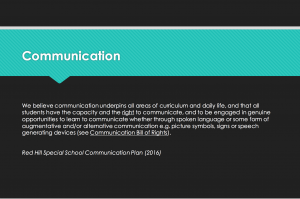This morning I was honoured and delighted to give a plenary presentation at the Queensland Association of Special Education Leaders (QASEL) 2016 conference. The presentation was on Augmentative and Alternative Communication – aimed at dispelling some myths and discussing good practice. I was lucky enough to have students and teachers from Claremont Special School and Red Hill Special School agree to contribute videos to the presentation. My sincere thanks to them for sharing.
You can view the full presentation below:
I also attended a fabulous presentation yesterday by three of the staff from Red Hill Special School – Kate, Rebecca and Dave. They put up a slide with a quote from their school’s communication plan that I wanted to share with you all! Go Red Hill!

And the hard to read reference list from the presentation is copied below:
References
Beukelman, D., & Mirenda, P. (1998). Building opportunities and nonsymbolic communication. In D. Beukelman & P. Mirenda (Eds.), Augmentative and Alternative Communication (2nd Ed., pp. 265–294). Baltimore: Paul H. Brookes.
Beukelman, D.R., & Mirenda, P. (2013). Augmentative and Alternative Communication: Supporting Children and Adults with Complex Communication Needs: Paul H. Brookes Pub.
DaFonte, M.A. (2008) The use of graphic symbols to demonstrate intentionality during early communicative interactions. Unpublished doctoral thesis
Kangas, K. & Lloyd (1988) Early cognitive skills as prerequisites to augmentative and alternative communication use: What are we waiting for?, Augmentative and Alternative Communication, 4(4), 211-221
Mirenda, P. (2014, ). Autism Spectrum Disorder and AAC. Session presented at the 2014 International Society on Augmentative and Alternative Communication Conference, Lisbon, Portugal.
Porter, G & Burkhart, L. (2010). Limitations with Using a Representational Hierarchy Approach for Language Learning. Retrieved from http://www.lburkhart.com/handouts/representational_hierarchy_draft.pdf
Romski, M.A. & Sevcik, R.A. (1988) Augmentative and alternative communication systems: Considerations for individuals with severe intellectual disabilities, Augmentative and Alternative Communication, 4(2), 83-93
Romski, M.A. & Sevcik, R.A. (2005) Augmentative communication and early intervention: myths and realities. Infants and Young Children 18 (3), 174
Sennott, S.C., Light, J.C. & McNaughton, D. (2016) AAC Modeling Intervention Research Review, Research and Practice for Persons with Severe Disabilities, 1 – 15
Speech Pathology Australia. (2012). Augmentative and Alternative Communication Clinical Guideline In The Speech Pathology Association of Australia Ltd (Ed.), Clinical Guidelines. Retrieved from http://www.speechpathologyaustralia.org.au/
UNESCO (1994) United Nations Universal Declaration of Human Rights. Retrieved from http://unesdoc.unesco.org/images/0009/000984/098483eb.pdf
Zangari, C. (2013) 3 Responses to Programs that Make Kids “Prove Worthiness” Prior to Providing Access to AAC. Retrieved from http://praacticalaac.org/praactical/3-responses-to-programs-that-make-kids-prove-worthiness-prior-to-providing-access-to-aac/.


Lisa Antley
jane
Barbara Locke
jane